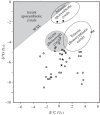Evidence of photosymbiosis in Palaeozoic tabulate corals
- PMID: 24307674
- PMCID: PMC3866410
- DOI: 10.1098/rspb.2013.2663
Evidence of photosymbiosis in Palaeozoic tabulate corals
Abstract
Coral reefs form the most diverse of all marine ecosystems on the Earth. Corals are among their main components and owe their bioconstructing abilities to a symbiosis with algae (Symbiodinium). The coral-algae symbiosis had been traced back to the Triassic (ca 240 Ma). Modern reef-building corals (Scleractinia) appeared after the Permian-Triassic crisis; in the Palaeozoic, some of the main reef constructors were extinct tabulate corals. The calcium carbonate secreted by extant photosymbiotic corals bears characteristic isotope (C and O) signatures. The analysis of tabulate corals belonging to four orders (Favositida, Heliolitida, Syringoporida and Auloporida) from Silurian to Permian strata of Europe and Africa shows these characteristic carbon and oxygen stable isotope signatures. The δ(18)O to δ(13)C ratios in recent photosymbiotic scleractinians are very similar to those of Palaeozoic tabulates, thus providing strong evidence of such symbioses as early as the Middle Silurian (ca 430 Ma). Corals in Palaeozoic reefs used the same cellular mechanisms for carbonate secretion as recent reefs, and thus contributed to reef formation.
Keywords: Palaeozoic; Symbiodinium; photosymbiosis; stable isotopes; tabulata; zooxanthellae.
Figures


Similar articles
-
Detecting Photosymbiosis in Fossil Scleractinian Corals.Sci Rep. 2017 Aug 25;7(1):9465. doi: 10.1038/s41598-017-09008-4. Sci Rep. 2017. PMID: 28842582 Free PMC article.
-
Stable Isotope Signatures of Middle Palaeozoic Ahermatypic Rugose Corals - Deciphering Secondary Alteration, Vital Fractionation Effects, and Palaeoecological Implications.PLoS One. 2015 Sep 3;10(9):e0136289. doi: 10.1371/journal.pone.0136289. eCollection 2015. PLoS One. 2015. PMID: 26334730 Free PMC article.
-
Photosymbiosis and the expansion of shallow-water corals.Sci Adv. 2016 Nov 2;2(11):e1601122. doi: 10.1126/sciadv.1601122. eCollection 2016 Nov. Sci Adv. 2016. PMID: 27847868 Free PMC article.
-
Circadian clocks in symbiotic corals: the duet between Symbiodinium algae and their coral host.Mar Genomics. 2014 Apr;14:47-57. doi: 10.1016/j.margen.2014.01.003. Epub 2014 Feb 5. Mar Genomics. 2014. PMID: 24508015 Review.
-
Coral photobiology: new light on old views.Zoology (Jena). 2015 Apr;118(2):71-8. doi: 10.1016/j.zool.2014.08.003. Epub 2014 Nov 3. Zoology (Jena). 2015. PMID: 25467066 Review.
Cited by
-
Coral photosymbiosis on Mid-Devonian reefs.Nature. 2024 Oct 23. doi: 10.1038/s41586-024-08101-9. Online ahead of print. Nature. 2024. PMID: 39443794
-
Functional consequences of Palaeozoic reef collapse.Sci Rep. 2022 Jan 26;12(1):1386. doi: 10.1038/s41598-022-05154-6. Sci Rep. 2022. PMID: 35082318 Free PMC article.
-
Detecting Photosymbiosis in Fossil Scleractinian Corals.Sci Rep. 2017 Aug 25;7(1):9465. doi: 10.1038/s41598-017-09008-4. Sci Rep. 2017. PMID: 28842582 Free PMC article.
-
Tabulate Corals after the Frasnian/Famennian Crisis: A Unique Fauna from the Holy Cross Mountains, Poland.PLoS One. 2016 Mar 23;11(3):e0149767. doi: 10.1371/journal.pone.0149767. eCollection 2016. PLoS One. 2016. PMID: 27007689 Free PMC article.
-
Stable Isotope Signatures of Middle Palaeozoic Ahermatypic Rugose Corals - Deciphering Secondary Alteration, Vital Fractionation Effects, and Palaeoecological Implications.PLoS One. 2015 Sep 3;10(9):e0136289. doi: 10.1371/journal.pone.0136289. eCollection 2015. PLoS One. 2015. PMID: 26334730 Free PMC article.
References
-
- Wood R. 1999. Reef evolution. New York, NY: Oxford University Press
-
- Goreau TF. 1959. The physiology of skeleton formation in corals. I. A method for measuring the rate of calcium deposition by corals under different conditions. Biol. Bull. 116, 59–75 (doi:10.2307/1539156) - DOI
-
- Scrutton CT, Clarkson ENK. 1991. A new scleractinian like coral from the Ordovician of the Southern Uplands, Scotland. Palaeontology 34, 179–194
-
- Han J, Kubota S, Uchida H-o, Stanley GD, Jr, Yao X, Shu D, Li Y, Yasui K. 2010. Tiny sea anemone from the Lower Cambrian of China. PLoS ONE 5, e13276 (doi:10.1371/journal.pone.0013276) - DOI - PMC - PubMed
-
- Ezaki Y. 1997. The Permian coral Numidiaphyllum: new insights into anthozoan phylogeny and Triassic scleractinian origins. Palaeontology 40, 1–14
Publication types
MeSH terms
LinkOut - more resources
Full Text Sources
Other Literature Sources


